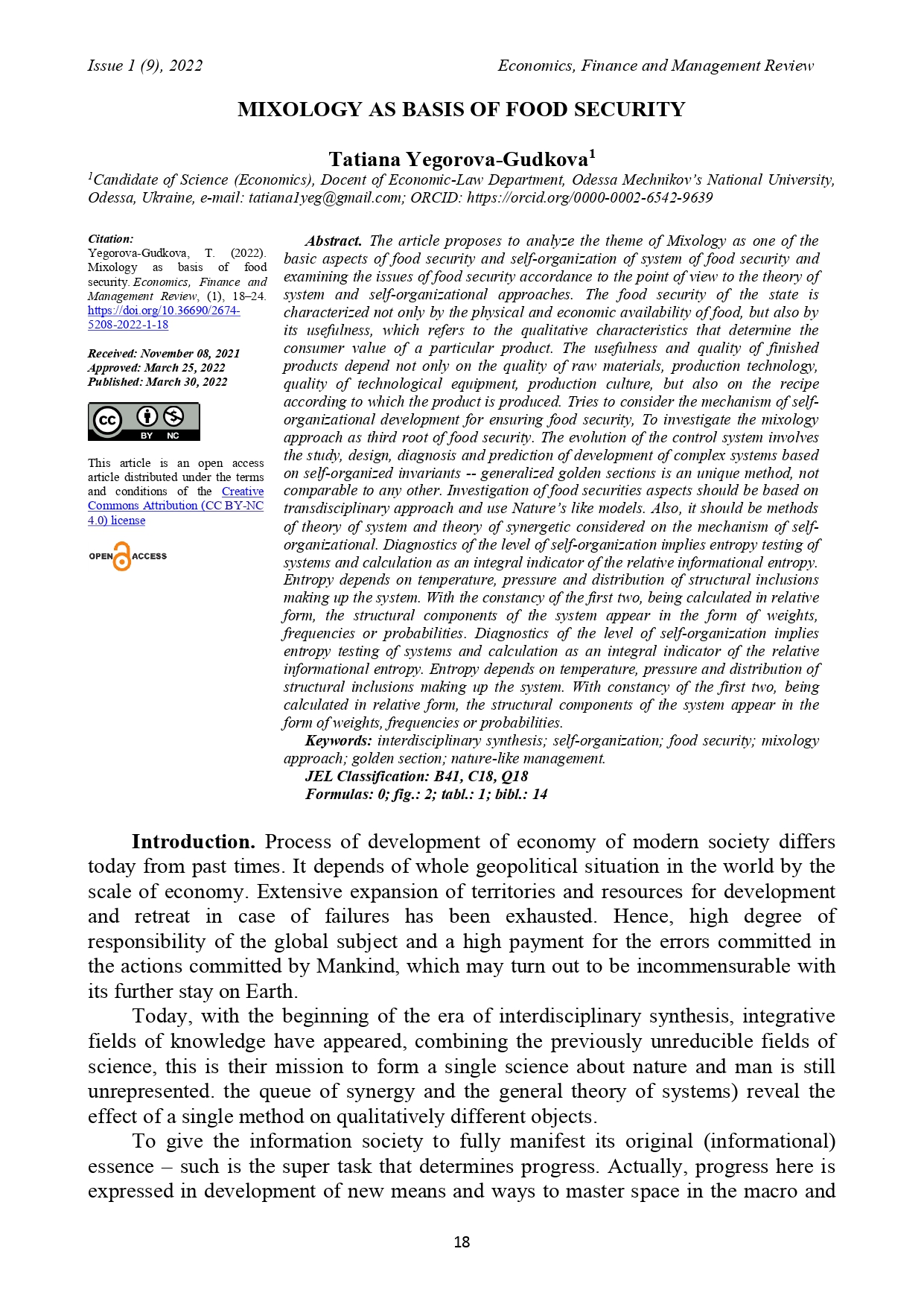Mixology as basis of food security
DOI:
https://doi.org/10.36690/2674-5208-2022-1-18Keywords:
interdisciplinary synthesis, self-organization, food security, mixology approach, golden section, nature-like managementAbstract
The article proposes to analyze the theme of Mixology as one of the basic aspect of food security and self-organization of system of food security and examining the issues of food security accordance to the point of view to the theory of system and self-organizational approaches. The food security of the state is characterized not only by the physical and economic availability of food, but also by its usefulness, which refers to the qualitative characteristics that determine the consumer value of a particular product. The usefulness and quality of finished products depend not only on the quality of raw materials, production technology, quality of technological equipment, production culture, but also on the recipe according to which the product is produced. Tries to consider the mechanism of self-organizational development for ensuring food security, To investigate the mixology approach as third root of food security. The evolution of the control system involves the study, design, diagnosis and prediction of development of complex systems based on self-organized invariants -- generalized golden sections is an unique method, not comparable to any other. Investigation of food securities aspects should be based on transdisciplinary approach and use Nature’s like models. Also it should be methods of theory of system and theory of synergetic considered on the mechanism of self-organizational. Diagnostics of the level of self-organization implies entropy testing of systems and calculation as an integral indicator of the relative informational entropy. Entropy depends on temperature, pressure and distribution of structural inclusions making up the system. With the constancy of the first two, being calculated in relative form, the structural components of the system appear in the form of weights, frequencies or probabilities. Diagnostics of the level of self-organization implies entropy testing of systems and calculation as an integral indicator of the relative informational entropy. Entropy depends on temperature, pressure and distribution of structural inclusions making up the system. With constancy of the first two, being calculated in relative form, the structural components of the system appear in the form of weights, frequencies or probabilities.
Downloads
References
Moiseev N.N. (1995). Bogdanov's tectology - modern perspectives. Problems of Philosophy. No. 8, pp. 8-13.
Soroko E.M. (2018). Golden sections. The processes of self-organization and evolution of systems. M. URSS, 234p.
Budanov V.G. (2006.). On the methodology of synergetics. Questions of philosophy. No. 5, p. 80.
Prangishvili I.V. (2000). A systematic approach and system-wide patterns. M .: Sinteg. 522 p.
Bertalanffy L. Von (1969). Research on General Systems Theory: Sat. translations. General ed. and will enter. Art. VN Sadovsky and E. G. Yudin. M .: Progress. pp. 23-82.
Nikolis G., Prigogine I. (1979). Self-organization in nonequilibrium systems: From dissipative structures to ordering through fluctuations. M .: Mir, pp. 71 - 72.
Institutionalism: Neoinstitutionalism. IE: Institutional economy. 2019. URL: http://institutional.narod.ru/history1/ch8.htm.
. Prigogine I. (1960). Introduction to the thermodynamics of nonequilibrium processes. M .: Publishing house of foreign. Literature.
Ziegler G. (1966). Extreme Principles of Thermodynamics of Irreversible Processes and Continuum Mechanics. - M .: Mir.
Grudanov, V.Ya. (2006). "Golden" proportion in engineering problems. Mogilev State University of Food. - Mogilev: Publishing house of Moscow State University.
Akhromeeva T.S., Kurdyumov S.P., Malinetskii G.G., Samarskii A.A. (1992). Non-stationary structures and diffusion chaos. M.: Science. 544 p.
Yegorova-Gudkova T.I., Krygin A.S., Boyko M.V. Economic security of the state: the influence of fundamental factors and development priorities. Market Economy: Modern Management Theory and Practice. http://dspace.onu.edu.ua:8080/bitstream/handle/123456789/20499/130-145.pdf sequence=1
Yegorova-Gudkova T.I. (2017). Some proportions of the economic system of the state in the conditions of developing a strategy for solving the crisis. Velyko Tyrnovo: Scientific proceedings of the Scientific Technical Union of Mechanical Engineering, Vol. 26/212 ,March. 2016. pp. 61–64.
Soroko E.M., Yegorova-Gudkova T.I., Tsai Bei. (2018). Formation of a financial model of economic growth: measure, measurement and mathematical constants. Naukove Vidannya. Collection of Science Theses of the V International Scientific and Practical Internet Conference, Financial system of the country: tendencies and prospects for development, Ostrog, 11-12 June 2018 p. Form of the National University "Ostrozka Academy". URL: Tezy_fin_systema_2018_web.pdf.
Mihus, I.& Denysenko, M. (2021). Methodical Approach to Assessing Food Safety of Ukraine. Proceedings of the 2nd International Scientific and Practical Conference “Modern Management Trends and the Digital Economy: from Regional Development to Global Economic Growth” (MTDE 2020) Retrieved from:https://doi.org/10.2991/aebmr.k.210320.001.

Downloads
Published
How to Cite
Issue
Section
License

This work is licensed under a Creative Commons Attribution-NonCommercial 4.0 International License.








